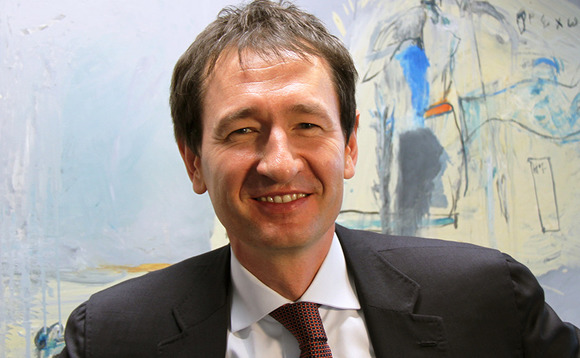
LP Profile: European Investment Fund

- €3.35bn exposure on equity side, equally split between venture and private equity
- First-time and emerging fund investment accounts for 45% of allocation
- Lower-mid-market focus
- Tickets between €10-120m
Head of equity investments Ulrich Grabenwarter tells unquote” how the European Investment Fund (EIF) deliberately pushes itself towards maiden funds and how 45% of its annual allocation lands in first-timer hands
Click here for a full data profile of EIF on unquote" data, including comprehensive fund investing preferences and history
"We deliberately seek exposure to first-time funds and 45% of our investment [allocation] every year goes to them," says Ulrich Grabenwarter, head of equity investments at the European Investment Fund (EIF). "We don't shy away from emerging fund managers."
In a nutshell, EIF exists to stimulate growth in the SME ecosystem by providing funding. It was set up in 1994 and is therefore one of the longest continuous investors in this space, with capital coming from the European Investment Bank, the European Commission and roughly 30 public and private financial institutions from EU states.
"We need to act like a private-sector investor and show that we are just as good, but at the same time we are not there to crowd out the sector" – Ulrich Grabenwarter, European Investment Fund
The fund currently has €3.35bn exposure to equity, with an almost equal 50-50 split between venture and private equity. There is a further €6bn of transaction value on the portfolio-guarantees business.
But EIF is mindful that this clout – especially coming from a partly state-funded body – could be seen as distorting the market. "We need to act like a private-sector investor and show that we are just as good, but at the same time we are not there to crowd out the sector," Grabenwarter explains, adding that once momentum has built in the fundraising process, EIF is prepared to scale back its commitment. "Often, after many generations, our exposure is over-proportional, especially in the first- and second-generation funds, but as they gain credibility based on their success, we decrease our exposure and reduce our commitment."
Selection of funds backed by EIF in 2017
| Fund | Fund type |
Amount raised (€m)
|
| FSI Mid-Market Growth Equity Fund | Buyout | 1,200 |
| EMH Digital Growth Fund | Venture | 350 |
| Med II | Buyout | 315 |
| Accent Equity 2017 | Generalist | 312 |
| LSP Health Economics Fund 2 | Buyout | 280 |
| Innova/6 | Buyout | 200 |
| Cipio Partners Fund VII | Venture | 174 |
| Idinvest SME Industrial Assets | Venture | 150 |
| Felix Capital Fund II | Venture | 138 |
| Seroba Life Sciences Fund III | Venture | 100 |
In some 70% of EIF's commitments to the VC market, the fund is a cornerstone investor. Recent examples include Balderton Capital in 2017; Atomico in 2016; EQT in 2016; Life Sciences Partners in 2017; and Wellington Partners in 2017.
"Even in the downward cycle when fundraising is hard, we invest, and this often gives us very satisfactory returns since we are present in vintage years where valuations are often less ambitious and investments deliver better returns," says Grabenwarter.
Relationships
Currently, EIF has 400 live relationships – roughly 200 with venture capital managers and the same again with private equity managers. These live relationships are funds in which EIF has deployed a ticket of between €10-200m, and which is yet to be returned.
"This number is likely to rise marginally in the next 12 months since we invest every year in some 20 new GP relationships," says Grabenwarter.
For a long time, EIF was a classic investor in VC funds, but the investor now backs funds targeting an extended risk capital market spectrum, from pre-institutional investments alongside business angels to growth-stage VC funds backing companies in their pre-IPO stage and beyond. On the late-stage VC side, EIF has notably backed the latest fund of Atomico.
"If we are not able to fund tech in Europe, companies will continue to move to the US and Europe will remain the incubator of technology for the US market" – Ulrich Grabenwarter, European Investment Fund
At a time when LPs are increasingly turning their sights to direct investing, the fund is not likely to follow suit. "EIF deliberately chooses not to do any direct investments, since it wishes to encourage a strong private-sector-managed fund investment ecosystem rather than compete with it," Grabenwarter says.
That is not to say that EIF is a funds-only investor, as it considers co-investment alongside funds in order to help overcoming capital shortage, especially in the growth VC segment.
The co-investment activity started in 2013 for tech investments and has since proven very popular with management teams, says Grabenwarter, though it currently only represents less than 10% of the fund's allocation.
"We added a co-investment activity backing tech companies at the late stage. The thinking came from the obvious lack of funding for tech leadership in Europe," he says. Grabenwarter adds that Europe has come a long way when it comes to growing tech market leaders, but the inability to launch to the next phase is a problem – as there is a very big lack of capital in the market. "As this dissatisfaction deepens, and if we are not able to fund tech in Europe, companies will continue to move to the US, and Europe will remain the incubator of technology for the US market," he says.
Latest News
Stonehage Fleming raises USD 130m for largest fund to date, eyes 2024 programme
Multi-family office has seen strong appetite, with investor base growing since 2016 to more than 90 family offices, Meiping Yap told Unquote
Permira to take Ergomed private for GBP 703m
Sponsor deploys Permira VIII to ride new wave of take-privates; Blackstone commits GBP 200m in financing for UK-based CRO
Partners Group to release IMs for Civica sale in mid-September
Sponsor acquired the public software group in July 2017 via the same-year vintage Partners Group Global Value 2017
Change of mind: Sponsors take to de-listing their own assets
EQT and Cinven seen as bellweather for funds to reassess options for listed assets trading underwater








